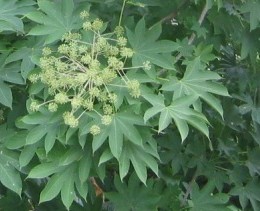 This relative of ivy is the only member of the family (Araliaceae) that is a large hardy tree. A native of China, Korea and Japan this deciduous tree has a tropical appearance with its large, lobed leaves that resemble those of the castor plant or maple tree. The leaves are glossy dark green in summer and turn dull yellow or reddish in the fall but are not considered showy. During the summer flowers are produced in showy, cream-colored, angelica-like heads that are followed in the fall by small black fruits that are attractive to birds. When the tree is young it is not particularly attractive due to its coarse, open appearance but with time it develops a round to oval shape with a pleasing crown. The branches are coarse and heavily armed with prickles that disappear on the older branches and trunk as the tree matures. The dark gray bark of the trunk develops ridges and furrows with age. This unusual tree is useful as a specimen or shade tree valued especially its lovely summer time bloom. Although easy to grow, castor tree does not tolerate the heat and humidity of the Deep South.
This relative of ivy is the only member of the family (Araliaceae) that is a large hardy tree. A native of China, Korea and Japan this deciduous tree has a tropical appearance with its large, lobed leaves that resemble those of the castor plant or maple tree. The leaves are glossy dark green in summer and turn dull yellow or reddish in the fall but are not considered showy. During the summer flowers are produced in showy, cream-colored, angelica-like heads that are followed in the fall by small black fruits that are attractive to birds. When the tree is young it is not particularly attractive due to its coarse, open appearance but with time it develops a round to oval shape with a pleasing crown. The branches are coarse and heavily armed with prickles that disappear on the older branches and trunk as the tree matures. The dark gray bark of the trunk develops ridges and furrows with age. This unusual tree is useful as a specimen or shade tree valued especially its lovely summer time bloom. Although easy to grow, castor tree does not tolerate the heat and humidity of the Deep South.
Type: Deciduous, flowering tree
Outstanding Features: Tropical appearance; abundant flowers in summer
Form: Upright, coarse, open when young becoming rounded to oval in maturity
Growth Rate: Medium
Bloom: Clusters of cream-colored flowers 12-24” across in summer; small black fruits in fall
Size: 40-60’ H x 40-60’ W
Light: Full sun; tolerates light shade
Soil: Fertile, moist, well drained; does not tolerate dry soil
Hardiness: Zones 4-7
Care: Low maintenance
Pests and Diseases: None of significance
Propagation: Seed.
